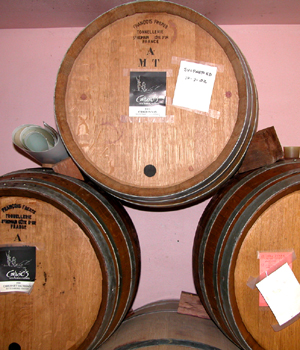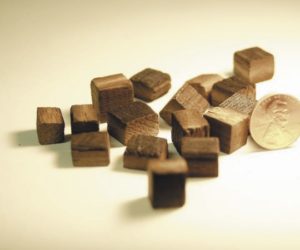The clay amphorae of ancient Rome are museum pieces long since lost from use in most modern winemaking. Some antique wine container styles, like the kvevri buried clay vessels in the Republic of Georgia, continue in use for specialized purposes. The oak barrel, though, has stood the test of time and continues in daily use around the world some two thousand years after the first one contained wine. Barrels can play a part in your home winemaking cellar, too.
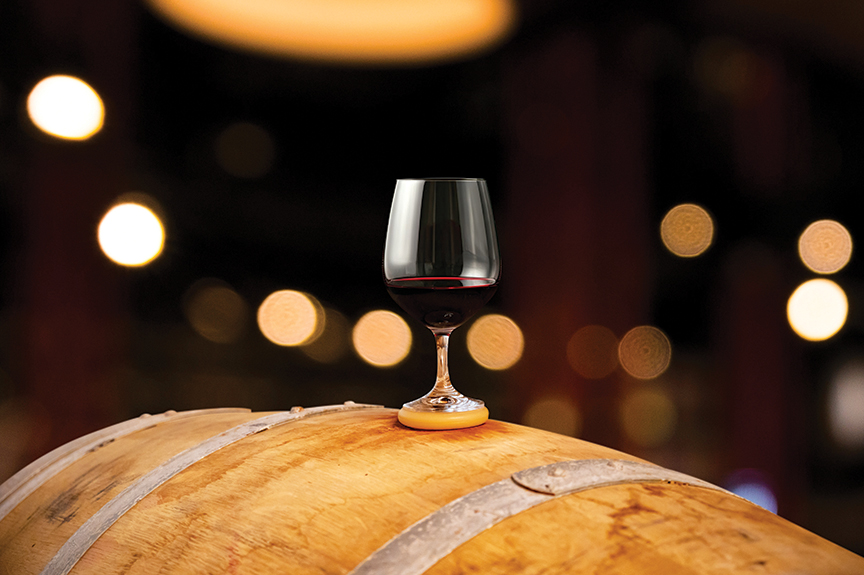
While there is some evidence of palm-wood barrels used for wine storage in the ancient Middle East, their use never displaced the amphorae of the time. When Roman armies moved north into Europe, they encountered oak barrels already being made and used by the people of ancient Gaul. The barrels were much more durable for shipping wine than clay vessels and stacked more readily. In what amounted to rapid technological development for the era, such barrels replaced clay amphorae in only about two hundred years. With continued use, vintners and consumers found barrels not only convenient and durable, but also discovered that wine often improved when stored in oak.
Anatomy of a Barrel
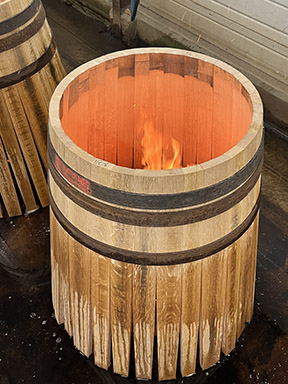
The pleasant oakiness we associate with wine aged in toasted barrels today came about as an indirect product of barrel manufacture. A barrel head is made of oak planks placed side-by-side and fashioned into a disk. Notched staves are assembled around the barrel head and steel hoops are installed to hold them in place. Because the staves are tapered at each end, the in-progress barrel has a basket shape with the staves splayed apart at the open end. To make the oak staves flexible enough to bring together around the other barrel head, they are heated. The traditional method to do this is to build a small fire from oak scraps and stand the splayed partial barrel over the fire until the staves become very hot. In a modern cooperage, the exposure to fire is carefully controlled to achieve the cooper’s target “toast” level. The original technique, though, is what caused the interior surface of the barrel to become toasted at all. Once the staves are hot enough, the barrel is inverted and a cable is tightened around another oak disk, bending the barrel to shape. That allows more hoops to be installed and the barrel can be finished. No nails or screws are used in the process.
Toasting transforms some of the native compounds of oak into aromatic or flavorful forms. While their development was incidental in early barrel making, the compounds are now studied and the toasting is carefully managed. Wine drinkers use terms like toast, vanilla, tobacco, and coconut to describe impressions from barrel-aged wines. Most of the barrel-aging compounds are polyphenolics — polymers built from hydroxy benzene ring structures. Volatile (aromatic) compounds like vanillin have pronounced effects on the flavor and aroma of the wine, while longer-chain polyphenolics — the tannins — affect mostly the mouthfeel of the wine. Now rarely used for shipping wine, barrels are valued at all levels of winemaking for the characteristics they impart while aging wine.
Sourcing Barrels
Once you have decided to include barrels as part of your home winemaking, your attention turns to sourcing. Commercial wineries often have an existing relationship with a cooperage or tonnellerie (the French equivalent). When it is time to add new barrels to their cellar, it is a matter of contacting their representative, discussing options and prices, and placing an order. While lead times can be substantial and barrels are expensive, the logistics do not confound regular commercial customers. As with other professional winemaking products also used by home winemakers, sourcing may not be so easy for the hobbyist.
If you make enough wine, alone or with a group of fellow hobbyists, the full-size 59- to 60-gallon (225- 228-L) wine barrel is the easiest one to find. While there are variations, two shapes are most common. The narrow, more cylindrical shape, is called a Bordeaux barrel and is usually about 59 gallons (225 L) in capacity. The Burgundy or Bourgogne shape is a bit wider through the middle and is often listed at 60 gallons (228 L). Most North American cooperages distribute barrels like these and some of them are willing to sell a single barrel to an individual customer. If you can order a new barrel from a cooperage, you will have other choices to make as well. One choice is between American oak and European oak (commonly French or Hungarian, but also possibly from elsewhere in Eastern Europe). If you specifically want a Europe-sourced barrel, there may be a significant lead time, so inquire well before harvest.
If you want a new, full-size wine barrel and cannot find a cooperage that will sell and ship one to you, you may be able to get some help from your favorite local winery. If you are a member of a wine club or have met the owner or winemaker, ask if they have a cooperage contact and if they plan to order barrels any time soon. If so, they may be able to piggyback an order for one or two barrels for you on their next order to help you out.
While my own “barrel program” is built around half-size wine barrels (26- to 29-gallon/100- to 110-L barrels), winery assistance helped me get my first one. I had introduced my brother, John, to Winemaker Alex MacGregor, then at Everett Ridge Winery in Sonoma County. After they met, my brother contacted Alex to ask for his help in getting me a surprise birthday present. Alex kindly assisted, adding a hectoliter French oak barrel to his next order with Seguin Moreau from their facility in Napa Valley. John picked up my new barrel at the winery when it came in and gave it to me for my birthday. (Alex MacGregor is now the Winemaker at Saracina in Mendocino County and I recommend a visit if you are in the area.)
Another good source for a new barrel is your local home winemaking shop. While there will not be as wide a range of options for barrel materials and toast levels, it is likely that many more sizes will be readily available. Here, the full-size wine barrel is probably the least common. Those barrels are bulky for the retailer to store and are too big for many home winemakers to use effectively. If your retailer does bring in full-size new barrels, it will probably be seasonal around harvest time. Prices will likely start around $1,000 and go up from there. Many more choices will likely be available in smaller sizes. Particularly in American oak, and sometimes Hungarian oak, there are barrels ranging all the way from 1 quart (1 L) for under $100 to ones like mine in the 26- to 29-gallon (100- to 110-L) range for under $1,000. The second barrel in my own program was sourced at retail. At that time, World Cooperage was producing 30-gallon (114-L) American oak barrels in addition to full-size barrels, which was a fit for my goals. Talk to the staff at your favorite home winemaking shop about stock or whether they can do special orders on barrels.
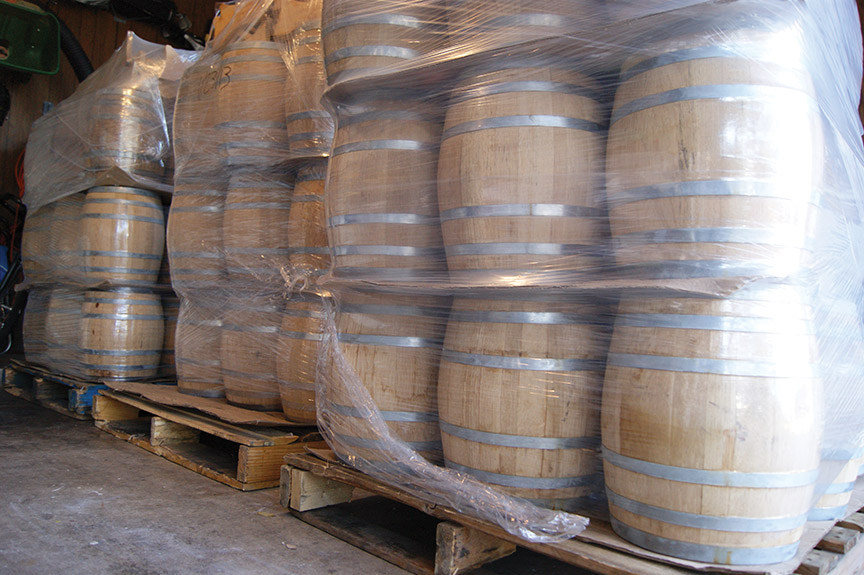
Since a barrel can be used more than once, the expense does not have as large an impact on your hobby budget as it seems at first. One way to lower the budget impact leads to my next sourcing suggestion: A recoopered barrel. A very large contributor to the cost of barrels is sourcing the high-quality, knot-free, tight-grained oak wood that goes into their construction. American barrel oak trees of the Quercus alba species have sufficiently tight grain that staves can be sawed from the wood parallel to the trunk. As a result, as many as four barrels may be made from a single tree. Staves from European oak trees of species Quercus robur or Quercus petraea, on the other hand, must be split rather than sawed to assure a leak-free barrel. Consequently, enough staves for just two barrels are produced from one such log.
With all that value going into the wood of the barrel, there is still intrinsic merit left when the barrel has been used several times and no longer contributes much oak character to wine stored in it. At that point, a specialty cooperage known as a recooper can restore much of the barrel’s utility for wine aging. Recoopering can be done to different sizes of barrels, but standard 59-gallon (225-L) barrels are most common. In some instances, the cooper removes one barrel head and removes the wine-soaked layer of wood from the inner surfaces. This can be done by mechanical sanding, scraping, or sandblasting with dry ice pellets. The barrel is re-toasted to a desired darkness and the remaining head planed and replaced. Some buyers of recoopered barrels are concerned these “whole barrel” techniques may leave wine residue where the intact staves meet the remaining barrel head.
To completely treat all the previously soaked wood, another recoopering technique is to completely disassemble the barrel, plane the wine-soaked wood off of the staves and head panels, and assemble a “new” barrel from the used staves. It is toasted by fire or by electric infrared heaters. While the new staves are thinner than the original staves, several more years of utility are made available. With complete disassembly, a barrel of a different size than the original can be made by trimming the staves. This is a good source for barrels in the 26-gallon (100-L) range at lower cost than a new barrel of the same size.
One other source of more economical barrels is used barrels. Although a barrel may be useful for four, five, or more uses, some wineries routinely retire their barrels after two or three uses because they emphasize the robust character of “new oak” in their wines. You may be able to buy such a barrel at a much lower price point than a new barrel and still get years of use out of it. Sometimes wineries sell used barrels directly and sometimes they sell them in lots to a barrel broker, who can then sell one to you. If you are considering buying a used barrel, make every effort to see and smell the barrel you are choosing before completing the deal. After the used barrels are washed or steam-cleaned, they may have been treated with sulfur dioxide gas. Because of that, be very careful if removing a bung to smell the interior of the barrel — it is hazardous to inhale sulfur dioxide. Assuming the barrel is safe to smell, you should detect odors of oak, toasted wood, and old wine. Odors of vinegar, indicating Acetobacter spoilage, or markers of Brettanomyces spoilage like barnyard or Band-Aid, should be absent in any barrel you accept. Buying used barrels is mostly restricted to the full-size examples as there is very little trade in smaller barrels among wineries.
Size Matters
Regardless of your barrel source, you will want to select one that meets the practical and artistic goals of your winemaking. A practical consideration is the physical size of the barrel. A standard Bordeaux barrel is about 27 inches (69 cm) in diameter at the widest point and a Burgundy barrel may be up to 28 inches (72 cm). With common door openings about 30 inches (76 cm) wide, check your cellar door before you buy such a barrel. If access is up or down stairs, you may also want to consider that such a barrel weighs between 88–110 lbs. (40–50 kg) when empty and dry. Since the best way to keep a barrel in good condition is filled with wine, you also need to regularly make more than 59 gallons (225 L) of wine, plus some for topping.
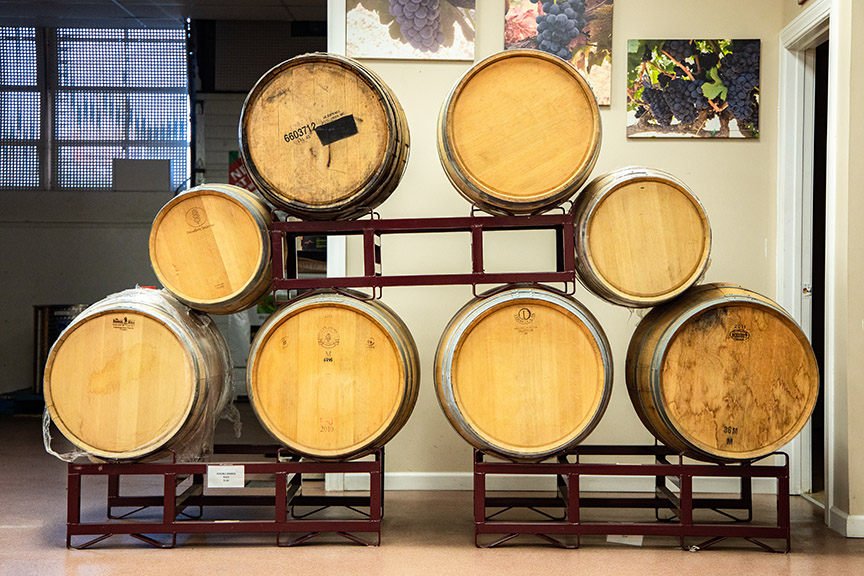
Considerations like these led me to my choice of half-size barrels as they are easy to handle when empty. I did not want to go much smaller, though, due to wine aging considerations. With a barrel approximating a cylinder, the surface area of increasingly large barrels goes up with the radius, but the volume goes up with the square of the radius. That means the larger the barrel, the lower the surface-to-volume ratio. In his excellent text Concepts in Wine Chemistry, Dr. Yair Margalit sums up these differences with a clear example. He notes that a 5-gallon (20-L) barrel presents 214 sq. cm of wood surface for every quart/liter of wine. A 53-gallon (200-L) barrel, in contrast, presents only 99 sq. cm per quart/liter. As a practical matter, that means a small barrel can over-oak a wine in a short time. My late business partner, Byron Burch, liked a simple rule of thumb for aging in different sizes of new barrels: One week per gallon (3.8 L) of capacity. So after little over a month, get that wine out of your 5-gallon (19-L) barrel. But a 59-gallon (225-L) barrel is probably alright for a year or more. Smaller barrels are easier to handle and fit home winemaker volumes, but they age wines much faster.
Not All Oak is the Same
With size decided, you can turn your attention to material. While chestnut and cherrywood barrels are sometimes used in vinegar making, almost all wine barrels are made from oak. Most commonly available oak origin choices are American, French, and Hungarian. Perceptions vary, but winemakers often find American oak to introduce fruity and spicy aromas, most prominently notes of coconut. French oak is usually perceived as more subtle, elegant, and structured. Hungarian oak, of the same species of white oak as French oak, offers similar sensory characteristics, with the main advantage being more economical pricing.
All oak wood used in wine barrels can introduce notes of vanilla, smoke, coffee, and chocolate, depending on toasting that is applied. After you decide the oak origin of your barrel, you will next consider the level of toasting. If ordering new barrels directly from a cooperage, you can probably get a barrel all the way from very light toast to extra heavy. If buying a barrel from retail stock, you will most likely see medium and medium-plus toast as your choices. In advising home winemakers about the differences, I like to use a literal toast analogy. Imagine you are toasting a slice of whole-grain bread to enjoy with your morning coffee. If you lightly toast it, the resulting snack will taste mostly of the whole-grain source, with only hints of burn or roast. However, if you heavily toast it, you get flavors and aromas expressing the burning and darkening, making the source flavors and aromas less prominent. Light toasted oak barrels contribute aromas closer to the wood itself, like vanilla and coconut. Heavily toasted barrels lean more toward the results of the fire, like tobacco and dark spices.
In addition to the esthetic considerations in choosing a new barrel, you will also want to consider the cost. Full-size barrels are too big to ship by parcel services, so you need to pick the barrel up yourself or have it shipped by truck.
Barrel Prep
After you pick up or receive your new barrel, you will need to prepare it for use. Do this a few days before you will fill it with wine for the first time. The barrel has been leak checked at the cooperage, but by the time it gets to you it may have dried out and the staves may have shrunk a bit. Even if it would not leak if filled with water, it probably will leak if filled with wine right away. Ethanol lowers the surface tension of a water (or wine) solution, so a water-tight container is not necessarily wine-tight. Put your new barrel in a place that can drain without damaging anything, support it on wedges or a rack, and fill with clean water. Even if water runs freely out between the staves, don’t panic. Whether you just have a few drips out the bottom or water running freely, top up with clean water again in a few hours. When you observe little or no drop in the water level at the bunghole over several hours, your barrel is ready to put into service. Pump or pour out the water and position the barrel bunghole down on a rack or blocks to completely drain. Leave the barrel draining for an hour or two and then move it to its wine aging location, again on a rack, wooden wedges, or blocks.
Pump or siphon your wine into the barrel, filling to a gap no more than 1⁄2 in. (1 cm) below the wood immediately around the bunghole (if you are barrel fermenting a Chardonnay rather than aging a fermented wine, fill only about 3⁄4 full to allow for foaming).
Different size barrels use different size stoppers, so be sure to arrange with your supplier in advance for one that will suit. I like to use silicone breather bungs in my barrels, even for finished wine. A change in temperature can cause expansion that could force out a solid bung, but the flap or plug on a breather bung will release any pressure while keeping air out. Another good choice, if the wine is completely stable, is to use a solid silicone bung. Despite long tradition, I do not recommend a wooden bung. Silicone conforms to the wood opening much better and provides a more secure seal. For a barrel fermentation, use a breather bung or a drilled rubber stopper fitted with an airlock.
If you have a very slow drip of wine out the lower side of the barrel (the bilge), you can probably just clean up the wine and otherwise let it go. It is likely due to the lower surface tension of the wine as compared with the water you used earlier. Once it soaks up the wine, the leak will most likely stop.
Barrel Repair
If a used barrels leaks so much that it is not suitable for use, there are home repair techniques. For a leak between staves or around the edge of the barrel head, use barrel wax. This is a block of soft paraffin wax sold at home winemaking stores. Empty the barrel and heat the leaking area with a heat gun or propane torch until it is too hot to touch, but not charring. Immediately rub the wax block on the hot wood. The wax will melt, soak in, and then solidify. It is odorless and tasteless and usually fixes any seeping sort of leak.
If instead your barrel leaks in the middle of one or more staves through tiny round holes, your barrel has been attacked by boring beetles — a good reason to not store barrels outdoors. For those leaks, you can buy spiles, little oakwood cones that look like undersized golf tees. Hammer a spile into the hole, then cut off and sand down the part sticking up above the surface.
Barrel-Aging Wine
Add sulfite and top up the barrel with the same (or compatible) wine every month or two, measuring the free SO2 at least every couple of months to maintain it as needed based on the wine’s pH. Most barrel-aged wines need to be racked only once or twice over the course of a year to achieve excellent clarity. When the time comes to rack, if you have another barrel you want to use, just prepare it in the same manner and pump the wine over. With a very small collection of barrels like my three, it is a bit more complicated. I pump the barrel contents into my 53-gallon (200-L) stainless steel tank, rinse the barrel out and drain for a few minutes, then put the barrel back on wooden wedges on my wine cellar floor. I then pump or siphon in any carboys of topping wine I may be aging at the same time, to give the entire batch some barrel age. Filling the rest of the way from the tank, I put in a clean silicone breather bung and continue the aging.
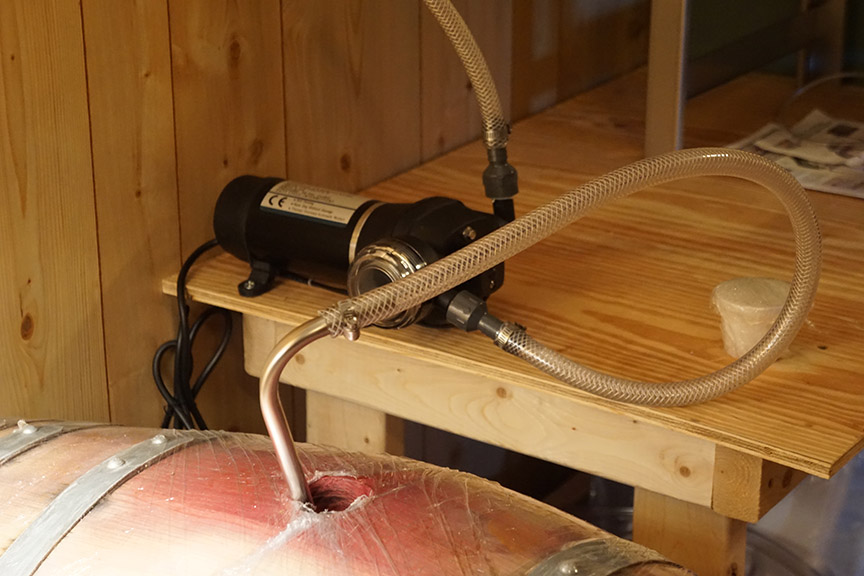
For as long as wine is in your barrel, you are getting more contributions from it than just toasted oak flavors and aromas. While there are excellent oak alternatives to provide those benefits in carboys or tanks, there is no hobby winemaking substitute for the slow and gradual micro-oxidation that a barrel provides. Wine slowly evaporates from the barrel either through the staves or between them. Oxygen enters the wine in small amounts, including when the bung is removed for topping. All of these interactions help tannins polymerize and become more mellow, rounding out the wine and giving it the barrel-aged character that winemakers cherish.
Barrel Reuse
Plans for the next use of your barrel begin when you empty it, either to transfer the wine to tanks or carboys or for bottling. Rinse the barrel out and drain it. Wash with a solution of water and sodium percarbonate or soda ash and rinse again. Rinse with a citric acid solution to sanitize, then drain and refill with new wine or store the barrel.
There are two wet storage techniques and one dry. I prefer either of the wet storage options for short-term storage. For storage of months or more, though, I like dry storage because it requires less attention. For wet storage, the first option is to make a solution of potassium meta-bisulfite and citric acid sufficient to fill 5–10 percent of the barrel capacity. Bung the barrel and slosh the solution around to contact the entire interior. Leave the barrel on end or on a rack and refresh the sulfite solution every month or two.
The second wet storage option is to completely fill the barrel with an acidified sulfite solution, which avoids the work of sloshing it around, but means you are using some of your barrel’s “oakiness” to oak the preservation solution. Again, refresh the sulfite from time to time.
For dry storage, after washing and draining the barrel, turn it bung-up and hang a sulfur stick on a wire from a bung — this is a good application for a wooden bung. Light the sulfur stick, lower it into the barrel, and avoid breathing the sulfur dioxide fumes that are produced. After two weeks, check the inside of the barrel with a flashlight. If the bilge still shows moisture, burn another stick and bung it up again. I find that when I check after two more weeks, the barrel is dry. Since I have a sulfur stick and matches in hand at that point, I burn the third and final stick. After this gassing and drying, you can bung up the barrel and store it on end or on a rack. Note that one sulfur stick is usually intended for a full-size barrel, so cut your sticks down for smaller barrels (e.g., I use a half stick each time). Suitable alternatives for gassing include burning sulfur disks suspended in a wire cage designed for that purpose. Follow supplier’s guidelines for size and number of disks to use.
After wet or dry storage, rinse out the used barrel and soak up just as for first use. If you have used a barrel several times and it is no longer contributing oak aromas and flavors, it may still be suitable as a container and it continues to allow the gentle oxidation that you get from barrel aging. To boost oakiness, you can add toasted oak sticks or spirals to the wine in the barrel. Some of these are designed specifically for barrel use, with a series of sticks drilled at each end and supplied with nylon zip ties to attach them end-to-end. Insert a chain of desired length into the neutral barrel and use monofilament fishing line to attach the last stick to a screw eye secured to the outside of the barrel near the bung. The monofilament line will fit easily alongside a silicone bung and allow removal of the oak chain later. Alternatively, you can use oak spirals, cubes, or beans, but you may need to wait until you empty the barrel to get them out.
Whether you are using new barrels, used barrels, or recoopered barrels, the possibilities for improving your wine by putting it in oak are endless. And if you ever get to the point where you decide a barrel is too old or too leaky to ever use again, you can always saw it in half to make two new planters.



